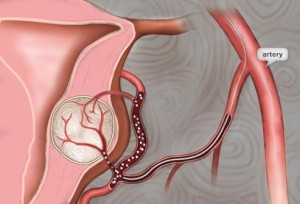 Uterine Fibroid Embolization (UFE), also known as Uterine Artery Embolization (UAE), is the top choice for a myomectomy or hysterectomy alternative. One-third of American women experience some type of pelvic health disorder by the
Uterine Fibroid Embolization (UFE), also known as Uterine Artery Embolization (UAE), is the top choice for a myomectomy or hysterectomy alternative. One-third of American women experience some type of pelvic health disorder by the
time they’re 60. And about 600,000 women every year have a hysterectomy — removing their uterus to relieve troubling symptoms. Overall, an estimated 20 million women have had a hysterectomy.
But if you have painful periods with excessive bleeding, fibroids, endometriosis, or another pelvic health problem, you should know that there is a hysterectomy alternative to consider.
Uterine Fibroids
These tumors, usually benign, are generally found on the smooth muscles of the uterus, and can cause pelvic pain, infertility, and heavy menstrual bleeding. Uterine fibroids are a major reason why women have hysterectomies, accounting for between 177,000 and 366,000 of the annual total.
If your fibroids are causing no symptoms, it’s entirely reasonable to adopt a strategy called “watchful waiting” — monitoring their status with your doctor and not having any surgery unless problems develop. But if you are experiencing pain, discomfort, or pressure, there are several less-invasive options for treating fibroids
Facts About Hysterectomy from Hysterectomy Alternative and Aftereffects
HERS Foundation
FACT: Women report a loss of physical sexual sensation after hysterectomy.
FACT: A woman’s vagina is shortened, scarred and dislocated by hysterectomy.
FACT: Hysterectomy’s damage is life-long. Among its most common consequences, in addition to operative injuries are:
- heart disease
- loss of sexual desire, arousal, sensation
- weight gain
- osteoporosis
- bone, joint and muscle pain and immobility
- painful intercourse, vaginal damage
- displacement of bladder, bowel, and other pelvic organs
- urinary tract infections, frequency, incontinence
- chronic constipation and digestive disorders
- debilitating fatigue
- loss of stamina
- altered body odor
- loss of short-term memory
- blunting of emotions, personality changes, despondency, irritability, anger, reclusiveness and suicidal thinking
- FACT: No drugs or other treatments can replace ovarian or uterine hormones or functions. The loss is permanent.
FACT: The medical term for the removal of the ovaries is castration. 73% of women are castrated during hysterectomy.
FACT: The uterus and ovaries function throughout life in women who have not been hysterectomized or castrated.
FACT: 98% of women HERS has referred to board-certified gynecologists after being told they needed hysterectomies, discovered that, in fact, they did not need hysterectomies.
FACT: Gynecologists, hospitals and drug companies make more than $17B dollars a year from the business of hysterectomy and castration.
HERS is the only independent, international organization dedicated to the issue of hysterectomy. HERS advocates for fully informed medical decisions by women.
Adverse Affects Case Study on 1000 women click here
Call 727-386-9981 now for a second opinion on a hysterectomy alternative
- Call to schedule a consultation: During your consultation you will be able to ask questions and be answered by a medical professional. This step will help you make an informed decision on whether embolization or hysterectomy is the right choice for you. Call 727-386-9981
- Day of consultation: https://www.grossmanmed.com/blog/cialis-online/ Please arrive 20 minutes before your appointment to fill out necessary paperwork and a health questionnaire. Bring any patient history such as (pap smear results, ultrasound or MRI imaging and notes from your primary care doctor or gynecologist). During your consultation you will be able to ask questions plus get knowledgeable information to help you make an informed and educated decision on what procedure works best for you on treating your fibroids.
- Return for MRI: Once you have decided to continue with the fibroid embolization, you will be scheduled for an MRI if you have not already had one. An MRI will provide us with images to prepare for your procedure.
- The day of your procedure: Please arrive 20 minutes before your appointment time to fill out additional paperwork and to go over simple instructions for your return home. Fibroid Embolization is a same day procedure, so you will be returning home that day with only a few days of down time. Please be sure to have someone with you. This person will be given a prescription for pain management as you will have minimal cramping and discomfort for a few days.